Transform your arid landscape into a thriving oasis with 27desert garden! We offer a curated selection of drought-tolerant plants. Discover practical gardening advice tailored for desert climates. Explore innovative design concepts to maximize your outdoor space. Learn how to create a stunning, low-maintenance garden in even the sunniest locations!
Designing Pathways with Natural Materials

Crafting walkways in a desert garden involves harmonizing aesthetics with the environment. The picture showcases an exquisite path constructed from native rocks. These rocks are carefully positioned, inviting exploration through the garden’s vibrant plant life.
The pathway’s updated design seamlessly integrates with the environment. A blend of gravel and smooth stones creates an inviting, natural aesthetic for all visitors. This thoughtful design offers a functional garden route and introduces an element of artistic beauty.
Selecting the right materials is key to complementing your garden’s style. Natural stone stands out for its long-lasting nature and earthy charm. Incorporating gravel can add visual interest and a relaxed vibe. This encourages visitors to wander and discover your outdoor space.
Keep up with pathway maintenance. A well-kept path ensures your garden stays welcoming. Regularly inspect for shifted stones and add gravel when necessary. This maintains safety and a pristine look in 2025.
Incorporating Native Desert Flora
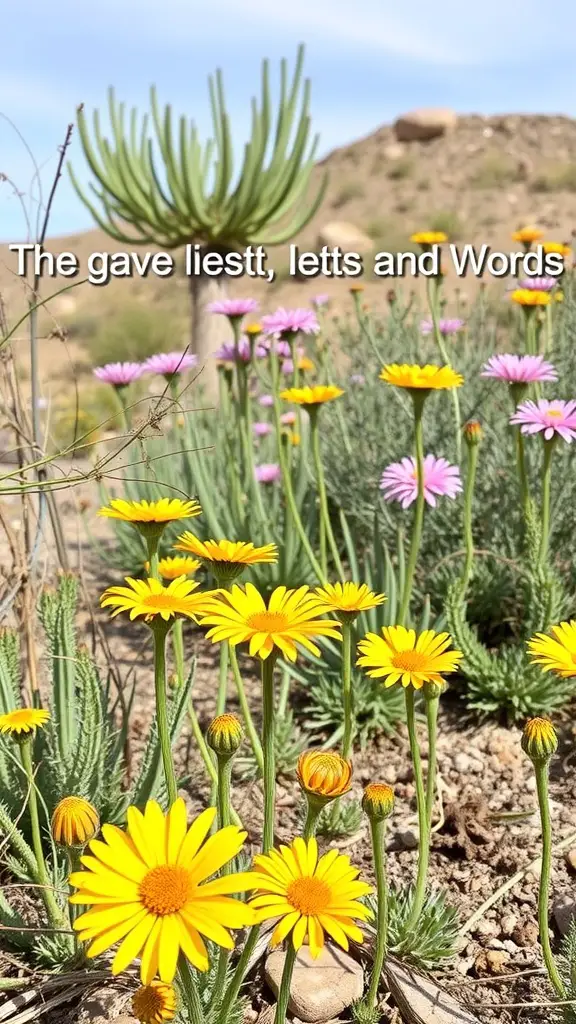
Crafting a desert garden means celebrating the resilience of indigenous flora. The picture showcases striking yellow and pink blossoms contrasting with the dry landscape. These vivid flowers are more than just visually appealing; they’re perfectly adapted to flourish in the challenging desert environment.
Opting for indigenous plants is an excellent strategy for effortless gardening. These species are naturally suited to the local environment, minimizing the need for extensive watering and upkeep. The vibrant yellow blossoms showcased here inject vibrancy into the scenery and draw in native pollinators, such as bees and butterflies.
Succulents and cacti enhance the arrangement with diverse textures. The tall, spiky plant in the back introduces appealing height. These elements combine to form a harmonious desert-inspired aesthetic.
Group plants based on their watering requirements. This simplifies garden maintenance and promotes sustainability. You’ll conserve water and foster a thriving backyard ecosystem.
Maximizing Sunlight Exposure

Sunlight is crucial for desert garden plants to flourish. This photo showcases diverse cacti and succulents, all evolved to maximize sun absorption. The tall, thin cactus efficiently gathers light from various directions. Meanwhile, the round, dense plants are ideally suited for water storage.
Optimizing plant arrangement by sunlight requirements is key. Taller cacti, for example, can offer shade to smaller plants during peak sun hours. This smart positioning maximizes light exposure and safeguards sensitive species.
Timing matters! Morning light is typically gentler, a perfect way to wake up your plants. Afternoon sun, however, can be intense. Knowing when to position your plants is key to their well-being in 2025.
Light-colored gravel or sand, like in the picture, reflects sunlight. This gives your plants an extra energy boost. It also creates a stunning contrast with the garden’s green and brown colors.
Understanding Soil Composition in Arid Regions
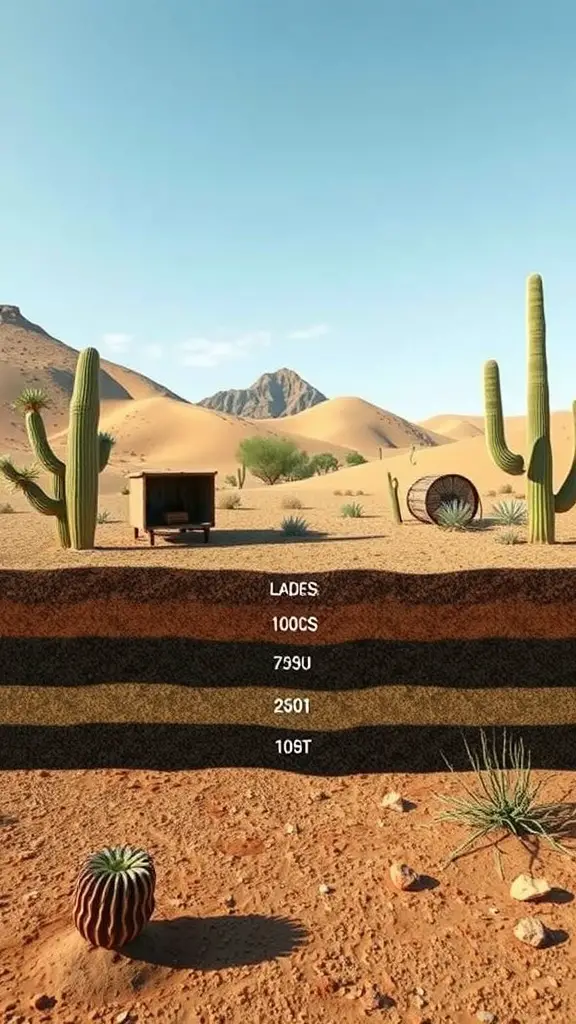
This image showcases a stark desert environment, highlighting the resilience of life in arid zones. Upfront, diverse cacti and desert flora flourish, demonstrating adaptation to harsh climates. The stratified soil beneath plays a crucial role, supporting the visible plant life above.
In dry regions, soil makeup is key for plant survival. This illustration shows how sand, clay, and organic elements combine. Each layer has unique traits affecting water storage and nutrient access.
Examine the soil layer labels carefully. They hint at a scientific method for analyzing desert soil types. For example, sandy soils offer rapid drainage but struggle to retain nutrients. Conversely, clay-rich layers excel at moisture retention, though they are prone to compaction.
Grasping these soil horizons reveals the secrets of plant survival, like cacti. They’ve evolved to conserve water and flourish in tough climates. Knowing soil makeup is key for gardening in such areas.
Utilizing Mulch for Moisture Retention

Mulch is essential for thriving desert gardens. It helps maintain plant health. This photo shows a garden with excellent mulch coverage. Wood chips and organic matter are spread across the soil.
Mulch functions as a soil cover, retaining vital moisture and minimizing water loss through evaporation. This is particularly beneficial in arid climates where water conservation is crucial. By insulating the soil, mulch helps regulate temperature, fostering optimal conditions for robust root development in 2025 gardens.
Various mulch options exist, including wood chips and straw. This photo showcases a blend that conserves moisture and enhances your garden’s aesthetic. Organic mulch decomposes, enriching the soil – a fantastic extra benefit!
Using mulch in your desert garden is an easy way to boost plant health and reduce water use. Whether you want a thriving garden or just want to keep your plants healthy, mulch is a valuable asset.
Creating Effective Irrigation Systems

Effective watering is key when planning your 2025 desert garden. The photo shows a black irrigation line winding across a sandy trail. This illustrates a clever method for watering in a dry environment.
Drip irrigation offers an excellent solution for targeted water delivery to plant roots. This efficient method conserves precious water resources. It also promotes healthy growth for your desert plants. The irrigation line pictured demonstrates this precise and effective watering technique.
Think about your garden’s design when setting up irrigation. Ensure the water lines cover every area efficiently, avoiding waste. The image shows how lines can follow the land’s shape, boosting water use.
Creating a consistent watering schedule is key. Aim for early morning or late evening. Cooler temperatures during these times reduce water loss through evaporation. This optimized timing significantly boosts moisture absorption for your plants.
Monitor the weather closely. Rain necessitates adjusting your watering plan. Regularly check soil moisture to fine-tune your watering. Success in desert gardening hinges on understanding and meeting your plants’ specific needs.
Selecting the Right Plants for a Desert Garden
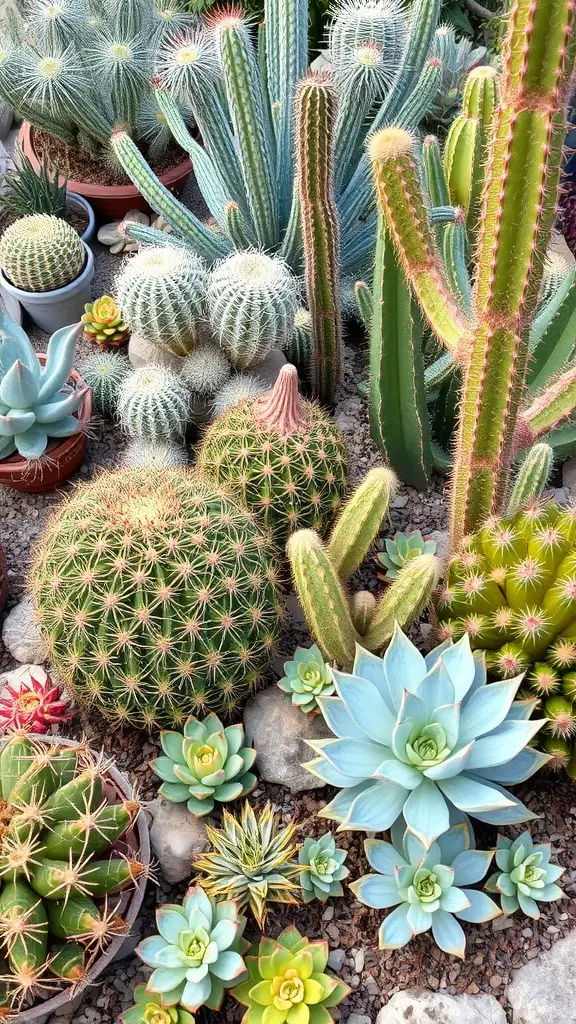
Crafting a desert garden is an enjoyable and rewarding endeavor. The picture displays a lively assortment of cacti and succulents. These plants are ideal for dry climates. Their distinctive forms and hues inject vitality into any open-air setting.
Begin your desert garden with cacti. The year 2025 offers even more stunning varieties. Explore options like the globe-shaped, prickly cacti and the towering, slim types. They provide both hardiness and visual interest, adding dimension to your landscape.
Succulents remain a fantastic option for gardens. As the image shows, they offer a wide array of colors and sizes. Their water-storing leaves simplify maintenance. Combining different succulents can produce stunning visual interest and maintain a vibrant garden throughout 2025.
Remember to evaluate your soil and drainage. Excellent drainage is crucial for a thriving desert garden. Opt for sandy soil to minimize the risk of root rot. Location matters too! Arrange plants with comparable sunlight requirements together for simpler upkeep.
Finally, keep in mind that certain plants draw in pollinators. These are great for your garden’s health. Adding flowering types can attract bees and butterflies. Have fun creating your desert paradise in 2025!
Integrating Wildlife-Friendly Features
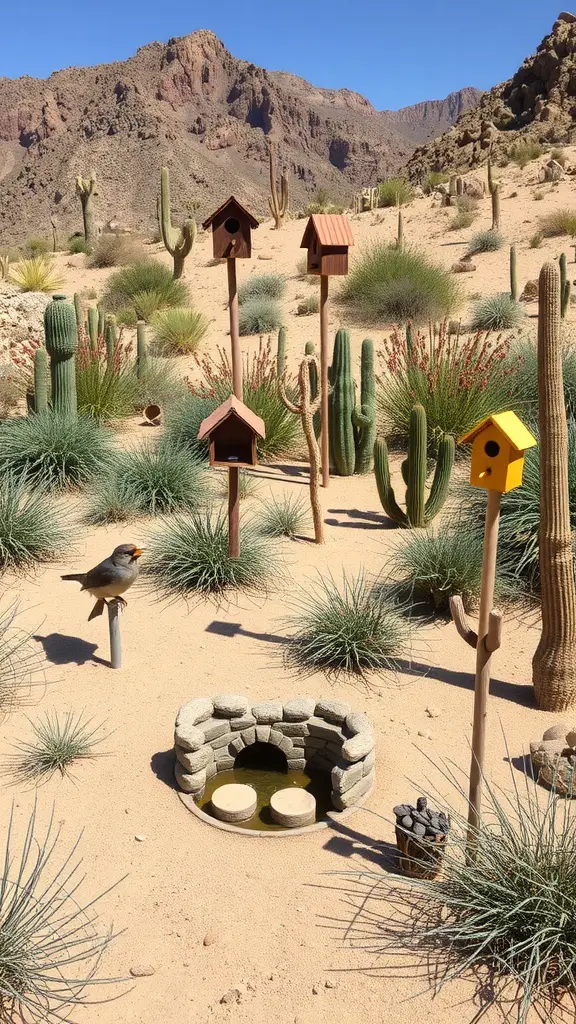
Designing a desert garden goes beyond mere beauty. It’s about attracting local wildlife. This photo highlights a clever blend of birdhouses and a small water source, perfect for drawing in diverse bird species. The birdhouses’ bright hues pop against the desert landscape’s natural, earthy shades.
Garden birdhouses offer secure nesting havens for our local avian friends. Selecting designs tailored to your region’s bird species is key. This boosts bird populations and enlivens your garden. Vibrant birdhouses, such as those pictured, create charming visual highlights.
The water feature also provides a cool oasis for birds to drink and bathe. Regular cleaning and refilling will keep it attractive to them. Small stones surrounding the water create a natural aesthetic and offer birds a place to perch. This feature benefits local wildlife and adds a calming touch to the surroundings.
Enhance your wildlife experience by integrating native plants near these features. Native flora draws in helpful insects and offers sustenance for birds. By combining these aspects, your desert garden transforms into a vibrant ecosystem. It invites the splendor of nature directly to your home.
Selecting Drought-Resistant Shrubs
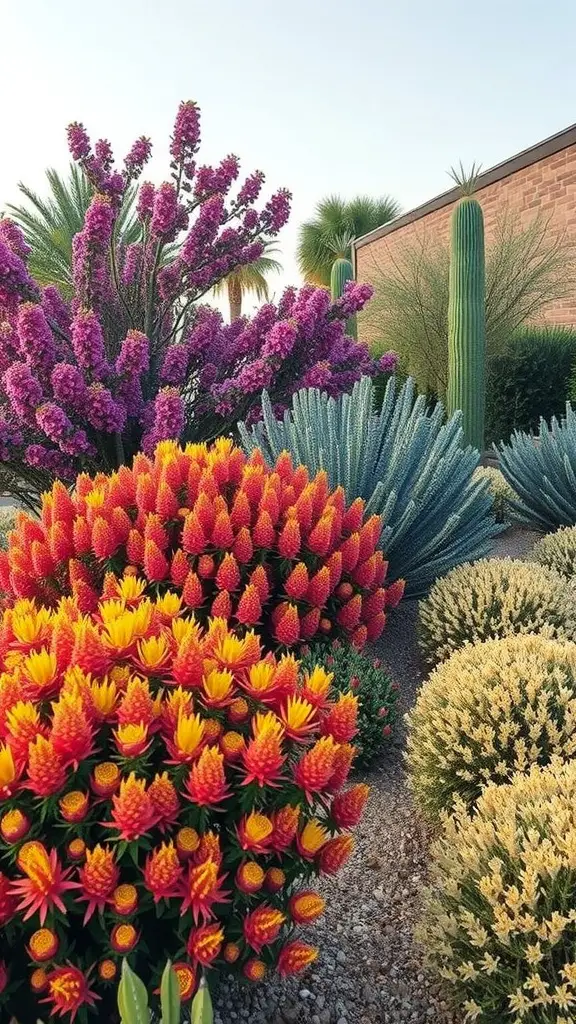
Crafting a desert garden? Prioritize drought-tolerant shrubs. This image displays a flourishing desert scene, bursting with colorful flora. The blend of purple, orange, and yellow hues results in a dynamic and balanced aesthetic. This variety is visually appealing and demonstrates the resilience of these plants in dry climates.
Elevate your 2025 garden with drought-tolerant shrubs. Lavender and sage are great options. They flourish in arid conditions and offer delightful scents. Succulents and cacti are also fantastic choices. Their distinctive forms and vibrant hues introduce a contemporary flair to classic desert landscapes.
Texture is key! The sharp cactus provides a stunning contrast to the gentle, round flowering shrubs. This creates depth and visual appeal in your garden. Choose plants that complement each other, considering their future growth.
Using Rocks and Boulders as Landscape Elements
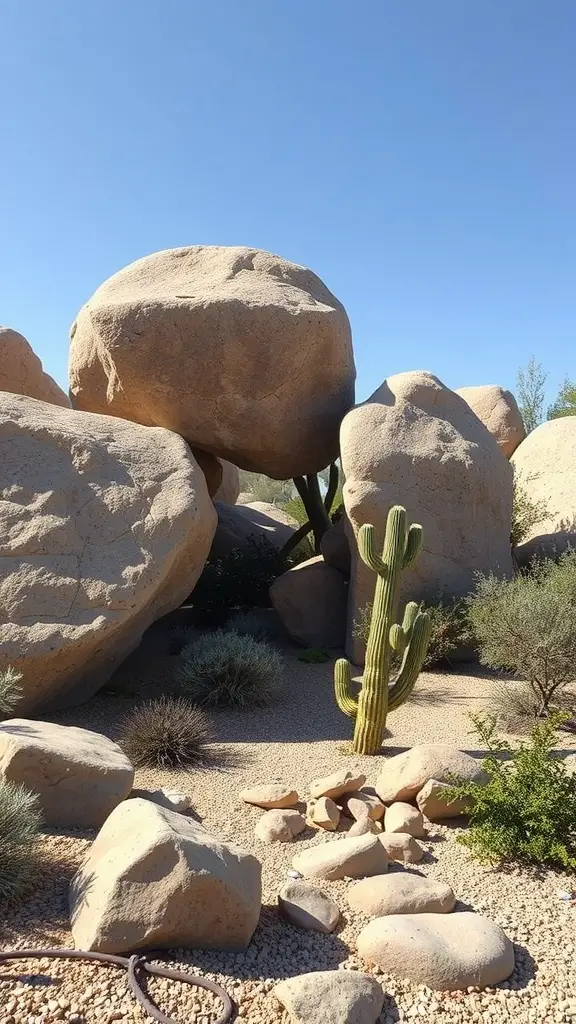
Desert gardens benefit greatly from the addition of rocks and boulders. This image features sizable boulders, crafting a natural aesthetic that harmonizes with the flora. These rocks offer a feeling of stability and power, enhancing the garden’s overall appeal.
Boulder placement directs your gaze, crafting paths and highlighting key features. Observe the towering cactus, a proud sentinel amidst the stones, injecting verticality and intrigue. This interplay of rigid and gentle components enhances the garden’s allure.
Rocks are excellent for desert gardens. They improve drainage and stabilize the soil. This is crucial in arid climates. The sand around the rocks promotes airflow. The rocks also hold onto some moisture. It’s a functional and attractive landscaping solution!
In 2025, incorporating smaller stones elevates your garden’s visual appeal. Use them to bridge spaces around larger rocks or design inviting pathways. This layered approach adds depth and captivates, making your garden truly stand out.
Enhancing Aesthetics with Decorative Gravel
Gravel enhances the visual appeal of desert gardens significantly. This photo showcases a curved pathway bordered by impressive cacti and vibrant plants. The colorful gravel provides texture and harmonizes with the surrounding natural landscape.
Selecting the perfect gravel elevates any outdoor area. Gravel’s diverse colors offer striking contrasts with plants and the sky. This simple choice significantly improves your garden’s aesthetic appeal.
Gravel offers practical benefits. It improves drainage and minimizes weed growth. This is particularly valuable in arid environments where water conservation is key. Using decorative gravel allows you to design a peaceful walkway, encouraging exploration and tranquility.
Incorporating Water Features Sustainably
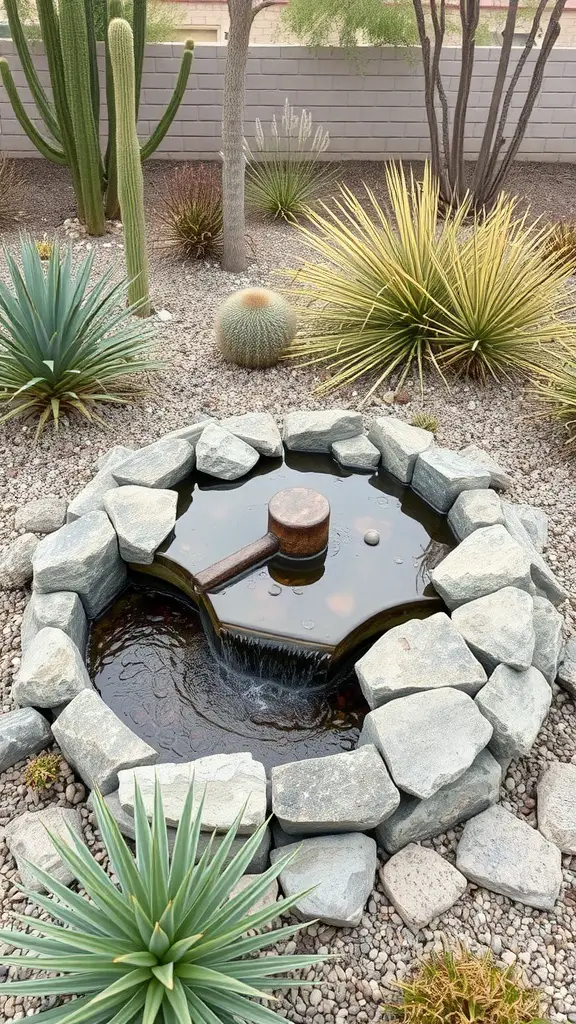
In 2025, water features elevate desert gardens to tranquil retreats. This photo presents a compact pond, artfully bordered by stones and diverse desert flora. This design is visually stunning and benefits native wildlife.
In 2025, sustainability remains paramount. This pond, for example, is designed for water collection and reuse, reducing waste significantly. Consider a simple pump to circulate the water, ensuring cleanliness and freshness.
Selecting drought-tolerant plants is key for water conservation. Succulents and cacti, similar to those near the pond, need very little water. They also introduce appealing textures to your garden. Grouping plants with comparable water requirements conserves resources and establishes a harmonious landscape design.
Consider rainwater harvesting for a sustainable pond. Channel rainwater to your pond, creating a self-sufficient ecosystem. This benefits your garden and helps the environment.
Lastly, remember the soothing sound of water! A gentle trickle from your water feature can mask unwanted noise. It fosters a tranquil and relaxing environment. This makes your desert garden a perfect escape for unwinding.
Building Raised Garden Beds for Drainage

Building a thriving desert garden requires excellent drainage. Raised garden beds offer a practical solution. Their elevated design promotes efficient water runoff, preventing root rot. This is crucial, particularly in sandy or clay soils prone to excessive moisture retention.
Observe the stunning raised bed design featuring diverse succulents and cacti. Each bed is unique, enhancing the garden’s aesthetic appeal. This design improves drainage and adds visual interest to your outdoor space.
Constructing raised garden beds begins with selecting durable, decay-resistant lumber such as cedar or redwood. Precisely cut the wood to your preferred dimensions for height and width. Firmly connect the corners to create a stable structure. Ensure adequate drainage by incorporating space for drainage holes at the base. Enhance drainage further by filling the beds with a well-blended mixture of soil and sand.
Elevate your garden’s beauty by including diverse plant species, mirroring the image’s design. Consider aloe, agave, and petite flowering succulents; they thrive in similar environments. Regularly rotate your plants for balanced sunlight exposure. Water them carefully, avoiding overwatering.
Creating Shade with Strategic Planting

Shade is invaluable in a desert garden. This photo showcases a stunning pathway. It’s bordered by palms and trees, creating a cool escape from the intense desert sun. The tall trees offer filtered shade. This allows plants and walkways to avoid direct sunlight.
Think about tree placement when designing your 2025 garden. Strategically position trees to form a natural canopy, turning sunny spots into inviting havens. Combining palm trees with diverse plants enhances beauty and offers practical benefits.
Low-growing ground cover thrives in shaded areas. It also boosts your garden’s aesthetic appeal. Opt for native, drought-tolerant plants to cut down on watering. This ensures a vibrant look. This strategy builds a sustainable retreat. It’s ideal for outdoor relaxation.
Consider incorporating shaded seating areas for ultimate comfort. A simple bench or a couple of chairs nestled beneath trees creates an inviting space to unwind. This setup lets you truly appreciate your garden, perfect for socializing or peaceful reflection. By selecting the right plants and designing thoughtfully, your desert garden can become a cool, shady retreat.
Employing Vertical Gardening Techniques
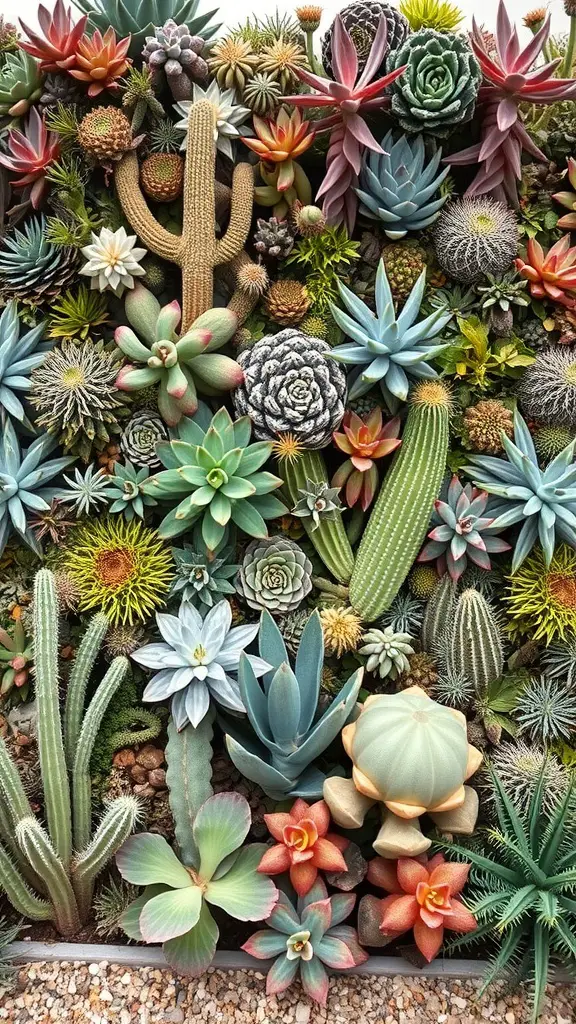
Vertical gardens offer a fantastic solution for adding plants to small spaces. Check out this vibrant display of succulents and cacti! Each plant contributes its distinct character, forming a charming miniature desert landscape. This trend is expected to grow even more in 2025.
Vertical gardens offer both beauty and space-saving benefits. Planting upwards allows you to grow more plants in less area, boosting your garden’s potential. This method is ideal for urban environments with limited space, letting you experience nature just outside your home.
Employing diverse shapes and colors enhances visual appeal. Observe the harmonious blend of plant textures, ranging from delicate succulents to sharp cacti. Personalize your vertical garden by combining plants that mirror your unique taste. Make it truly your own!
Vertical gardens are also incredibly easy to maintain. Succulents, known for their resilience, need very little care. This makes them ideal for those with busy schedules. Their drought resistance is a huge advantage, especially in drier regions. You can enjoy a beautiful garden without constant watering.
Considering a vertical garden? Succulents are a fantastic choice! They’re resilient, vibrant, and guaranteed to brighten your day.
Planning for Seasonal Changes
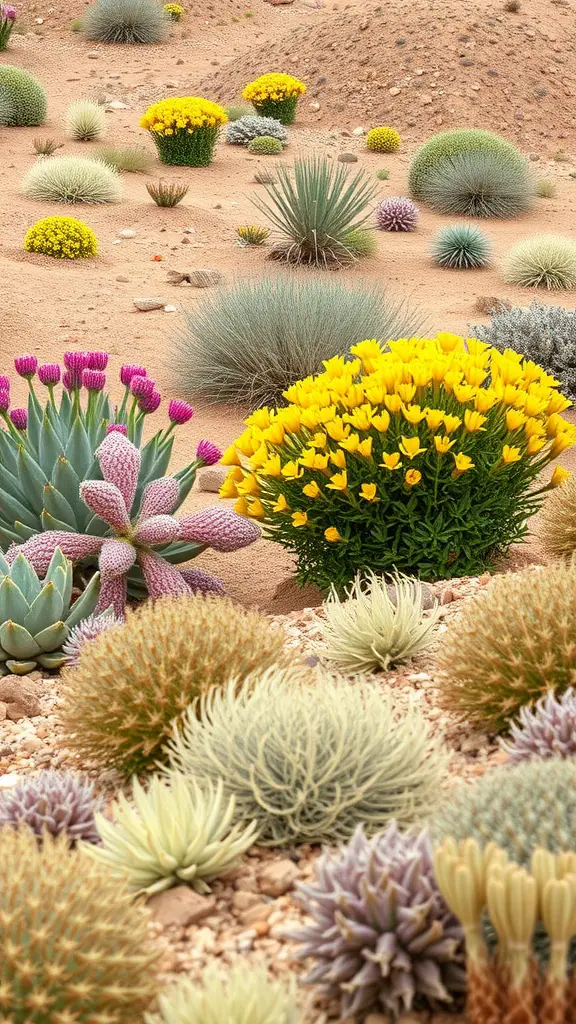
Desert garden success hinges on adapting to seasonal shifts. This photo displays a lively array of cacti and blooming flora flourishing in a sandy environment. The diverse textures and hues emphasize the allure of a carefully designed garden.
Plan your garden thoughtfully, observing how plants adapt to changing seasons. The vibrant yellow flowers in front bring joy each spring. Simultaneously, the soft green succulents offer a beautiful, consistent background throughout the year.
Adjust your watering routine with the changing seasons. During hotter periods, plants often require more frequent hydration. Conversely, in cooler temperatures, let the soil dry out between waterings. This crucial step prevents root rot and promotes robust plant health.
Consider plants that provide year-round visual appeal. Select diverse species for a constantly evolving landscape. Integrate plants with unique forms, such as succulents, to enhance your garden’s depth.
Creating Microclimates Within the Garden
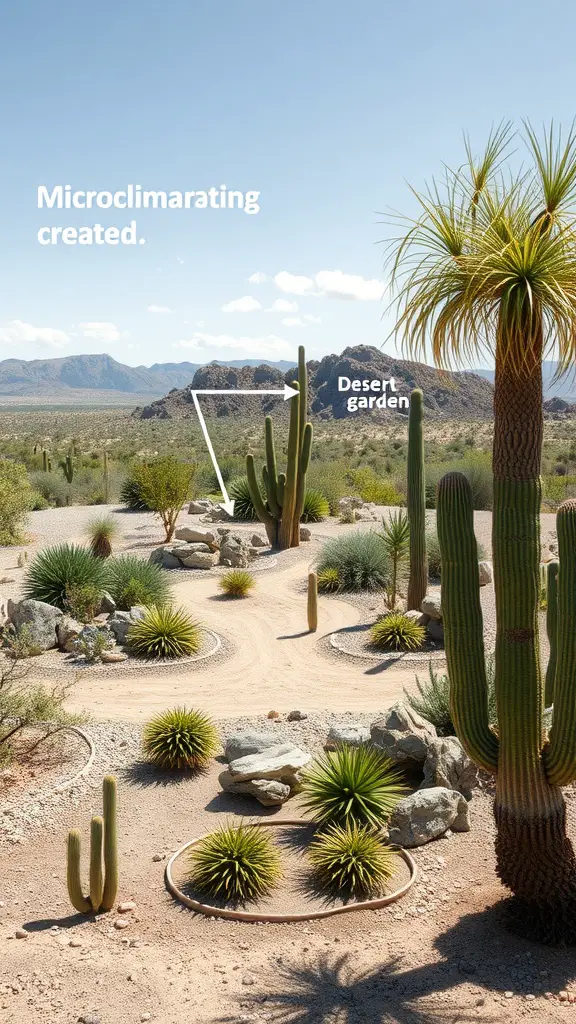
In 2025, desert gardens thrive by utilizing microclimates. This is key for plant variety and vitality. The picture showcases a thoughtfully planned desert scene. Notice how curves and strategically placed rocks alter sun exposure and water retention.
Microclimates are localized zones with distinct weather conditions compared to their surroundings. Observe how careful placement of plants and rocks in this garden creates shade and retains moisture. This enables a wider variety of plants to flourish, even under challenging environmental stresses.
Leveraging indigenous flora, such as cacti and succulents, significantly improves these microclimates. These plants are uniquely suited to the harsh desert conditions. They thrive in the cooler zones established by bigger plants. Placing them close to rocks offers extra protection from intense sunlight.
Finally, garden paths and layout matter. The curved paths in the picture enhance airflow and add visual appeal, boosting the ecosystem. Remember, even minor garden adjustments can create a healthier, more lively environment. Consider this for your 2025 garden plans!
Emphasizing Color Contrast with Foliage

Desert gardens thrive on color contrast, a vital element for captivating visuals. This photo highlights a diverse collection of plants, each contributing its distinct shade. The bright yellow flowers pop against the gravel’s natural hues, attracting attention and encouraging discovery.
Textured leaves create garden depth. Spiky plant shapes, in vibrant red and yellow, offer a dynamic display. These contrasting colors energize the space. They transform a simple landscape into a lively masterpiece.
Effective color contrast elevates your garden experience. Walking through a vibrant space sparks curiosity. You’ll appreciate nature’s artistry. It reminds us that life flourishes beautifully, even in dry environments.
Lighting for Evening Ambiance
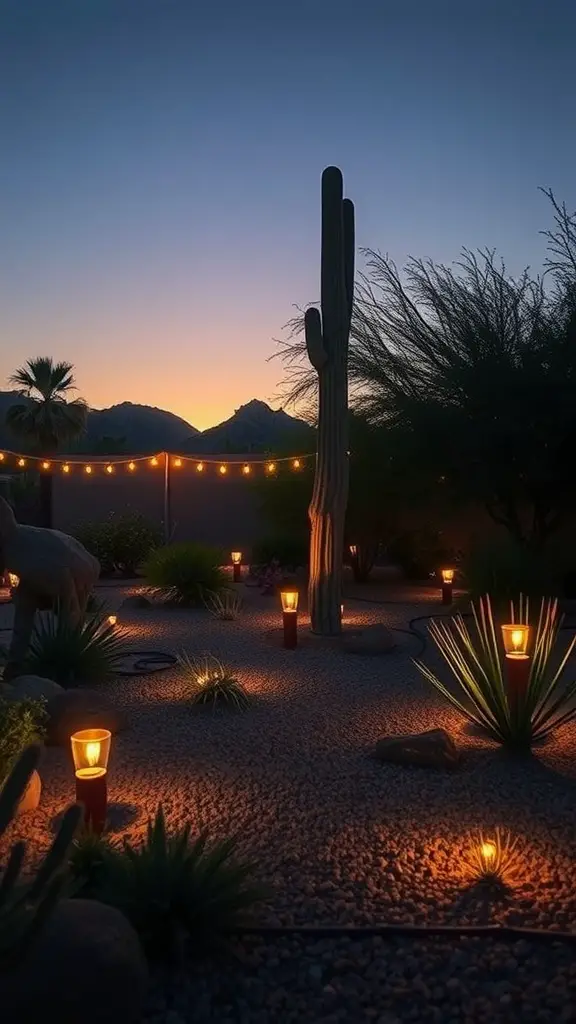
When the sun dips below the horizon, your garden’s lighting can create a relaxing haven. This photo showcases how inviting warm lights can be when placed among gravel and plants. The gentle illumination offers a stunning contrast to the evening sky, encouraging you to unwind and enjoy the ambiance.
Overhead string lights create a delightful ambiance. They softly illuminate the area, ideal for evening events or peaceful stargazing. Combine them with ground lights to showcase desert flora. Highlight striking cacti and colorful agave plants to amplify the natural landscape’s allure.
Crafting the perfect evening atmosphere involves balancing practical and aesthetic lighting. Ensure sufficient brightness for easy movement, while maintaining a gentle, inviting glow. Combining various light sources is key to creating a relaxing and visually appealing garden retreat in 2025.
Choosing the Right Mulching Techniques

Mulching is key to a thriving desert garden. The picture highlights various mulching options. These materials improve your garden’s health and beauty.
Observe the dark, dense mulch on the left. It appears rich and well-packed. This organic type decomposes, enriching the soil with vital nutrients. It excels at moisture retention, ideal for hot weather conditions.
The space to your right features a blend of pebbles and wood mulch. It’s an excellent choice for dry climates, reducing water loss and controlling weeds. Furthermore, it enhances your yard’s appeal, complementing the natural desert aesthetic.
Selecting the appropriate mulching method is crucial. Consider your plants’ specific requirements and your area’s weather patterns. For example, rock mulch works well for plants that thrive in dry conditions. On the other hand, organic mulch is a better choice for plants that need more moisture.
Engaging with Local Gardening Communities
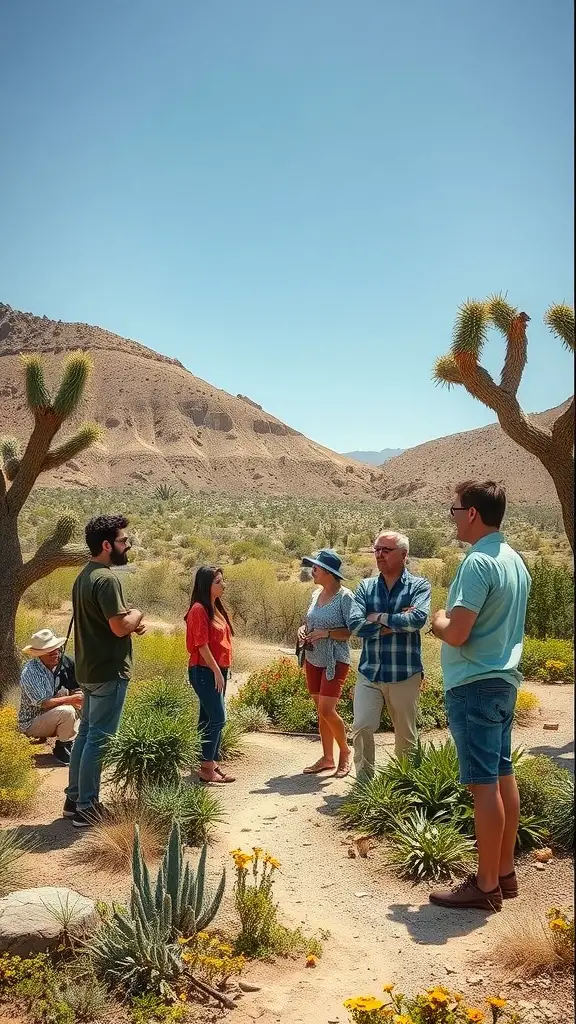
Engaging with nearby gardening groups offers fantastic benefits. The photo displays individuals in a desert garden, amidst indigenous flora such as cacti and vibrant blossoms. This scene exemplifies how community members exchange knowledge while enjoying the splendor of their regional ecosystem.
These meetups are great for exchanging sustainable gardening know-how. Discuss water conservation or share plant care advice. You’ll discover ideas to revolutionize your garden.
Participating in local workshops or events, perhaps in a beautiful desert garden setting, connects you with fellow enthusiasts. Forge friendships, exchange plant cuttings, and team up on local initiatives. It’s a fantastic way to deepen your community ties while improving your gardening expertise.
If you love gardening, connect with local gardening clubs! A wealth of information awaits you. You might even find unique plant varieties specific to your area. Explore the possibilities!
Maintaining Your Desert Garden Year-Round
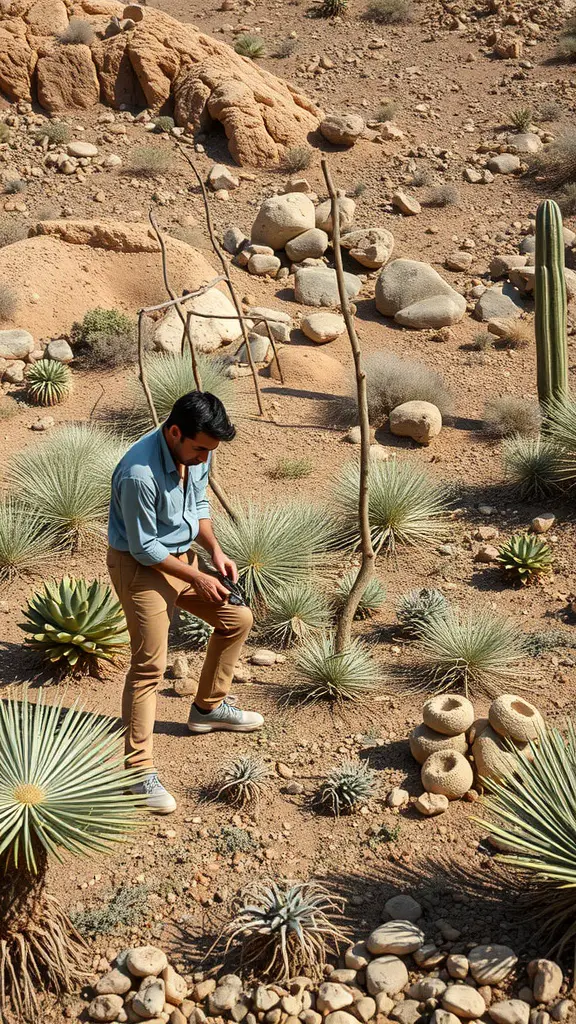
Desert gardens are delightful and easy to care for. They showcase unique beauty and require minimal watering. This photo features someone caring for a lively desert garden. It’s full of diverse succulents and cacti. The sandy soil and rocky ground highlight the desert’s natural charm. Consistent care helps these plants flourish, despite the tough environment.
Proper watering is key for plant health. Water deeply but less often. This encourages roots to grow downwards in search of water. During hot weather, check soil moisture often. Water when the top two inches feel dry to the touch.
Regular pruning is key for thriving plants. Removing dead leaves and faded flowers boosts plant health and aesthetics. Here, the gardener meticulously inspects each plant. This close attention ensures the desert garden remains vibrant and well-maintained.
Mulching plant bases conserves moisture and fights weeds. In arid climates, gravel or stone mulch safeguards soil and boosts visual appeal. The image’s texture contrast shows how natural elements elevate garden design in 2025.
Finally, pest control is essential. Inspect your plants regularly to avoid infestations. Early detection and treatment will protect your desert garden. These easy maintenance steps ensure your garden flourishes year-round.
Exploring Edible Plants for a Desert Garden
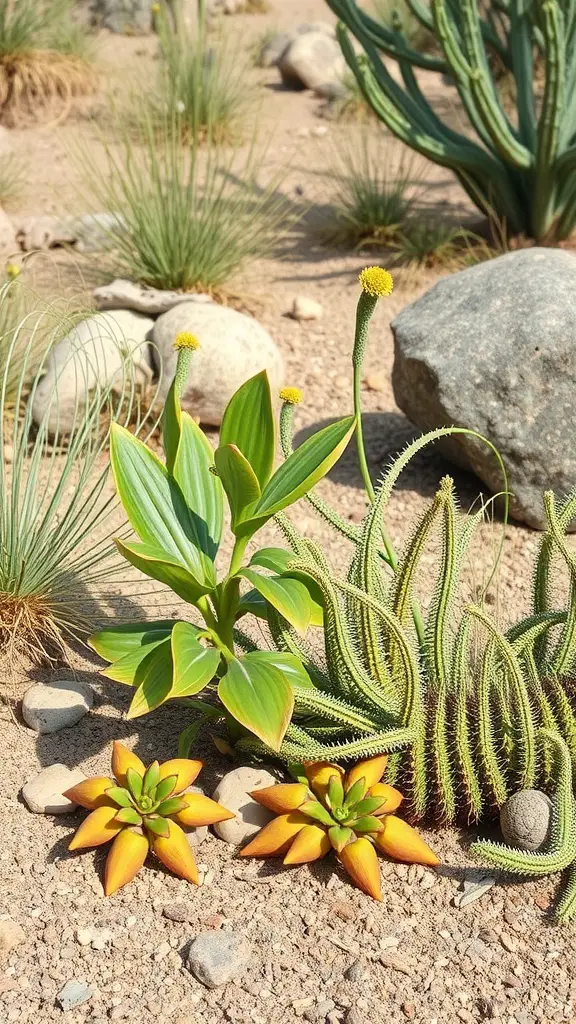
Crafting a desert garden is an engaging way to appreciate the stark beauty of arid environments. You can even integrate edible plants! The image showcases diverse flora flourishing in dry climates. These plants enhance your garden’s unique appeal and offer delicious ingredients for your culinary creations.
The two striking succulents in the foreground boast unique, star-shaped designs. Beyond their beauty, they’re often culinary ingredients. Many succulents are edible, some offering notable health advantages. Use them in salads or as garnishes for a fresh, flavorful touch to your meals.
Beyond succulents, discover more edible desert flora. Certain cacti yield delicious and healthy fruits. The lush green plants behind them may offer edible flowers or leaves. These are ideal for flavoring your dishes.
Design your desert garden with a diverse selection of these resilient plants. They’ll flourish even in tough environments. Many also offer unique flavors to elevate your culinary creations. Growing your own food in your backyard is incredibly rewarding!
Implementing Companion Planting Strategies
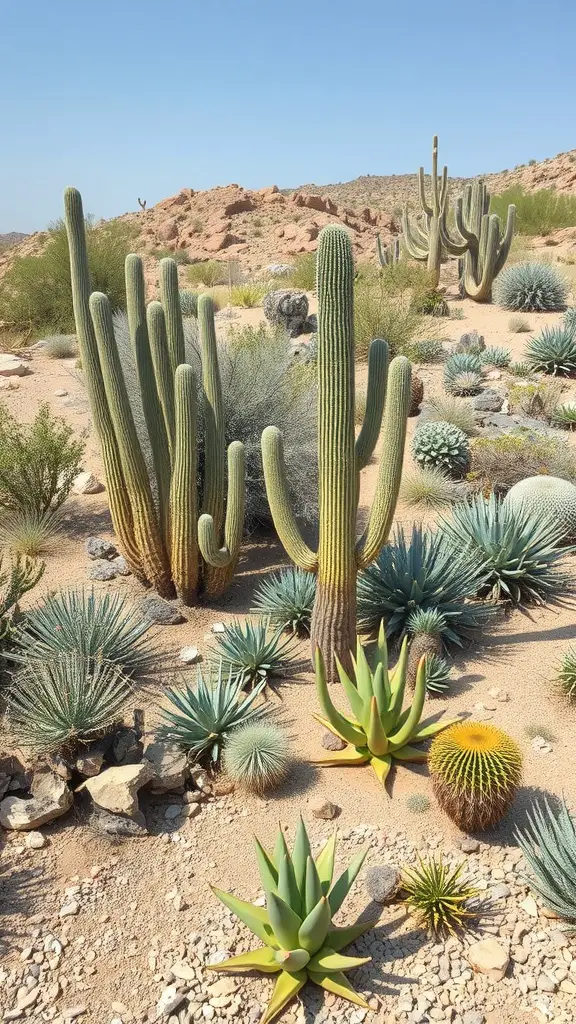
Imagine a desert garden: a haven of specialized plants thriving in challenging environments. This scene displays diverse cacti and succulents, demonstrating their ability to flourish in harmony. Their varied forms, dimensions, and hues compose a stunning, robust ecosystem.
Strategic companion planting is key to a thriving desert garden. Select plants that benefit each other. For instance, some succulents offer crucial shade and retain moisture for delicate plants. This helps them thrive in arid climates. Tall cacti provide vertical interest and act as windbreaks. This creates a protected microclimate for nearby plants.
Begin by integrating low-water plants with highly drought-resistant species. The agave, showcased with its rosette form, complements smaller succulents beautifully. This pairing boosts visual interest and optimizes space and water usage.
Grouping plants based on their water and sunlight requirements is a smart strategy. This simplifies your watering schedule and promotes healthier growth. The image highlights how careful plant placement results in a thriving and balanced garden.
Using Art and Sculptures to Enhance Landscape

Elevate your desert garden with art and sculptures to create a stunning oasis. This image showcases how artistic pieces seamlessly integrate with the natural environment. Notice the striking contrast between the towering cacti and the sculptures’ soft, curved shapes, perfectly capturing the spirit of the desert.
These striking sculptures command attention, inviting closer inspection. Their minimalist forms introduce a contemporary feel, harmonizing with the garden’s organic essence. The sculptures’ natural hues beautifully enhance the sandy ground and verdant cacti, resulting in a unified aesthetic.
Incorporating diverse textures and materials elevates the ambiance. Observe the assortment of stones and the distinctive plant arrangement, creating both depth and visual appeal. This deliberate design encourages exploration, appreciation, and reflection on the connection between nature and human ingenuity.
In 2025, integrating art elevates your landscape design beyond mere aesthetics. It becomes a powerful expression of your unique personality and story. Each carefully chosen artwork can transform your garden into an inviting and captivating space. From striking statement pieces to delicate artistic touches, discover the perfect way to seamlessly blend art into your desert oasis.
Creating Areas for Relaxation and Reflection

Life in 2025 is hectic, making a tranquil retreat vital. This image presents a beautiful outdoor area designed for relaxation. A comfortable chair, complete with plush cushions, encourages you to sit and savor the peace.
The wall’s inviting, warm colors create a friendly atmosphere. It’s an ideal setting for the vibrant plants nearby. Towering cacti and palm trees form a natural barrier, offering a secluded, oasis-like feel.
Personalize this area to make it truly yours. A small table is perfect for your beverage or a good read. Add plants to create a peaceful, natural vibe. This garden is more than just pretty; it’s ideal for get-togethers or peaceful moments of thought.
Consider lighting to elevate the atmosphere. Gentle lights or lanterns create an inviting space as evening approaches. This area is a perfect reminder to pause, appreciate the surrounding beauty, and unwind. It’s an ideal relaxation retreat.
Celebrating Cultural Heritage Through Garden Design

A desert garden’s image showcases cultural heritage through smart design. These landscapes use native plants. These plants flourish in dry climates and share the region’s history and culture.
Up front, diverse cacti species dominate the scene, instantly recognizable as desert dwellers. These plants represent strength and adaptability, key values in cultures surviving challenging climates. Their varied forms and dimensions create visual appeal, highlighting nature’s blend of practicality and artistry.
Smooth stones and minimal greenery surround the cacti, fostering a peaceful setting. The use of natural elements respects the environment and elevates the garden’s beauty. This plant and rock combination mirrors classic landscaping methods, highlighting a profound respect for nature.
The backdrop features stunning architectural details, steeped in historical significance, enhancing the garden’s cultural story. These elements showcase the harmonious blend of buildings and landscapes, celebrating local traditions. This highlights that gardens are more than just flora; they embody a sense of place and cherished memories.

